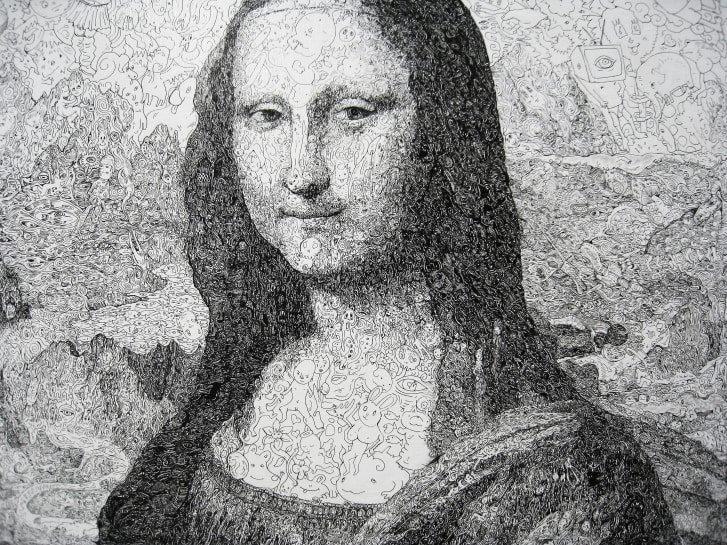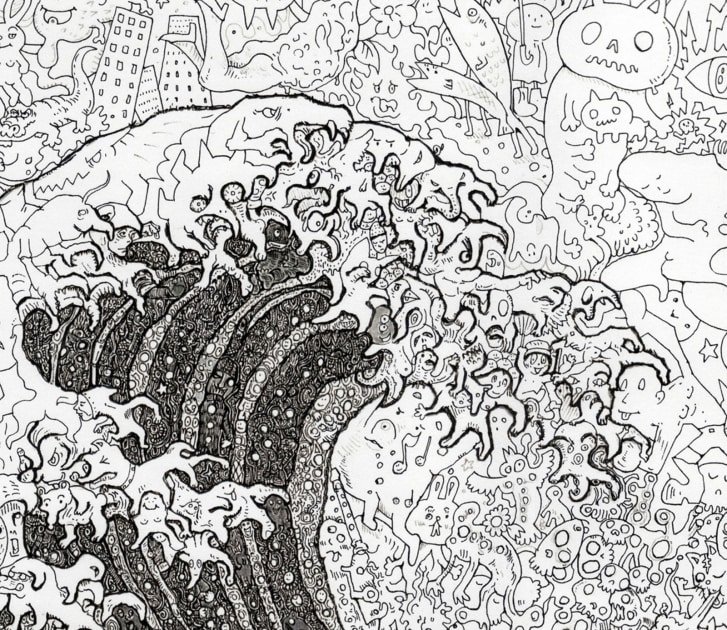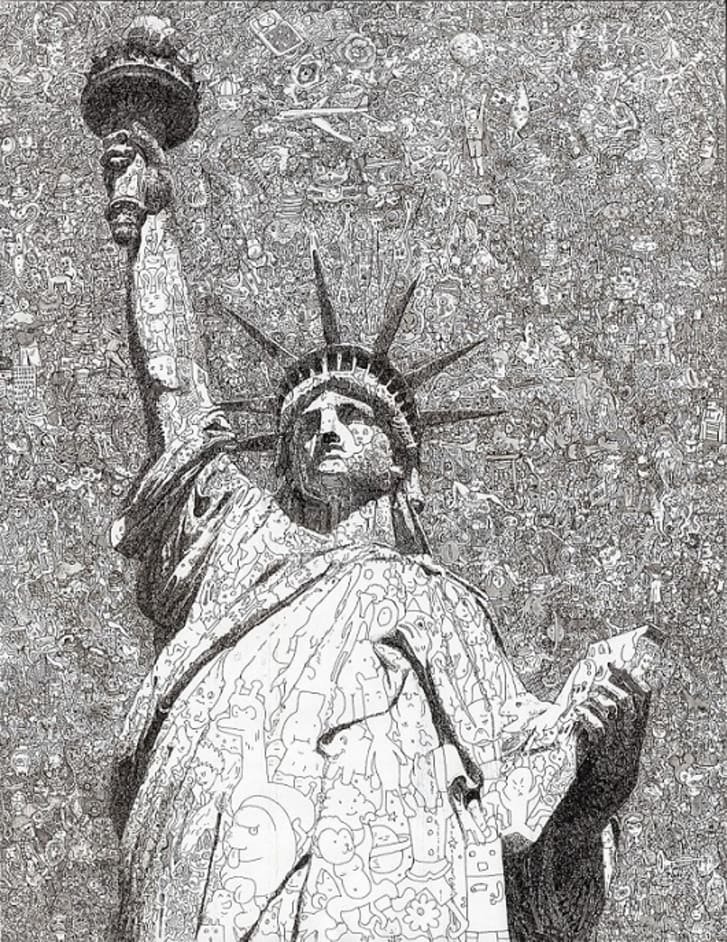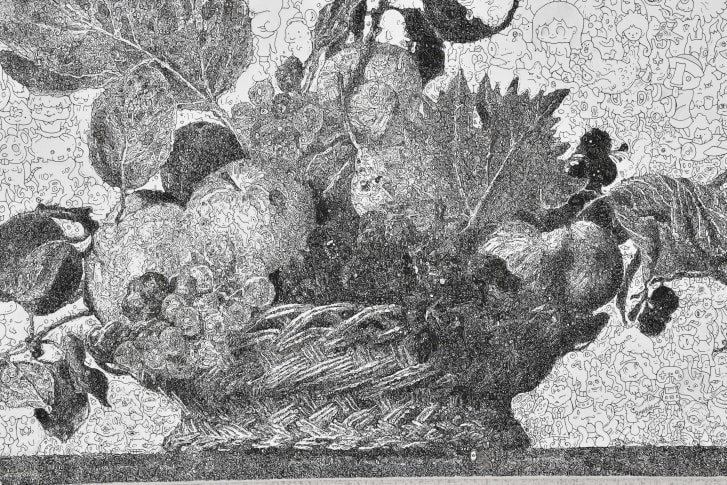
eonardo da Vinci's "Mona Lisa" is one of the world's most reproduced and reinterpreted paintings -- but no one has done it quite like Japanese artist Keita Sagaki.
From a distance, Sagaki's replica looks like a pen-and-ink version of the original. But a closer inspection reveals that the picture is composed from hundreds of tiny cartoon characters. A drawing of a dog lies along the Mona Lisa's cheekbone, while a smiling cat sits on the end of her nose. A cartoon of the planet Saturn can be found floating on her forehead.
Some of the characters might look familiar to fans of Japanese anime and manga. But while all of the cartoons in his works are technically original, Sagaki admits that he is heavily inspired by artists and collectives like Osamu Tezuka, Fuji Fujiko and Studio Ghibli.
High and low, East and West
The "Mona Lisa" isn't the only Old Master painting that Sagaki has reproduced using manga-inspired characters -- he has also created his own versions of Leonardo's "The Last Supper," Botticelli's "The Birth of Venus" and Hokusai's "The Great Wave off Kanagawa," among others.
He began reproducing famous artworks in his distinctive style back in 2004, seeing it as an interesting way to combine Western art with the manga and anime characters he'd loved as a child.
"Western paintings and Japanese art contain many conflicting concepts," Sagaki explained in an email interview. "Western paintings offer depth, while my characters are flat. Even in many classical Japanese paintings, perspective is not used much."
This fusion of Western masterpieces with Japanese pop culture has won Sagaki fans all over the world, with his art appearing in exhibitions as far afield as Germany and Portugal. He's currently preparing for an exhibition at Hong Kong's Fabrik Gallery in March, where he'll unveil new works based on Baroque paintings. Among them are reproductions of "Boy with a Basket of Fruit" by Caravaggio, "Girl Reading a Letter at an Open Window" by Johannes Vermeer and "A Woman Bathing in a Stream" by Rembrandt.
The show's curator, Jason Sveinn, believes that the appeal of Sagaki's drawings lies partly in the way they treat manga and anime as serious art forms.
"Sagaki actually dreamed of being a manga artist drawing cartoons when he was a kid," Sveinn said in a phone interview. "He used to draw cartoons in his notepad, and he thought to himself, 'Maybe I should do something interesting with this; maybe I can apply this technique to works that I can see in a museum.'"
Spiritual undertones
Sagaki doesn't produce drafts of his artworks. Instead, he draws directly onto paper using a 0.015-inch black pen, referring to images of the painting that he's reproducing. Sagaki's drawings vary in scale, from roughly the size of a sheet of A4 paper to enormous works almost 10 feet wide. Given that a single mistake could ruin an entire work, Sagaki takes his time when drawing, and some works take as long as a year to complete.
"Sagaki is an example of a true Japanese artist," Sveinn said. "What I mean by this is that he secludes himself in his studio, quietly and patiently drawing. He's incredibly focused."

This approach is partly inspired by an interest in Buddhism, Sagaki said. One of his earliest memories is visiting the Toga Meiso no Sato meditation center in Japan's Toyama prefecture, where several mandalas (intricate, richly colored Buddhist paintings representing the cosmos) were on display. As with Sagaki's art, mandalas are composed of tiny individual parts that combine to create a whole image.
"My style and mandalas have some things in common," Sagaki explained. "First of all, they are very detailed depictions. And in the creation process, drawing, for me, is like meditation. That is exactly how mandalas were created."
Yet, Sagaki's inspiration is also deeply rooted in the Western tradition. When deciding which masterpiece to reproduce, he uses a strict set of criteria -- most importantly, that the painting has to be famous.
"A picture that everyone knows gives rise to a big 'gap' between looking from far away when it appears to be a straightforward reproduction," he said, "and looking closer when the anime detail becomes clear."
Sagaki also chooses paintings that feature stark contrasts, so that he can vary the density of his anime characters. But despite the apparent accuracy of his reproductions, Sagaki admits that he often recreates Old Master paintings without ever seeing them first-hand.
"I saw the original beforehand for about half of my works," he said. "But after I've created my work, I want to see them. I went to see the 'Mona Lisa.'"
Hi! I am a robot. I just upvoted you! I found similar content that readers might be interested in:
https://www.cnn.com/style/article/keita-sagaki-masterpieces-manga/index.html